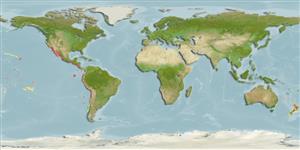>
Anguilliformes (Eels and morays) >
Ophichthidae (Snake eels) > Ophichthinae
Etymology: Ophichthus: Greek, ophis = serpent + Greek, ichthys = fish (Ref. 45335); triserialis: Name from Latin 'triserialis', 3-rowed, for the patterin of spots.
More on author: Kaup.
Environment: milieu / climate zone / depth range / distribution range
Ecologia
marinhas demersal; intervalo de profundidade 1 - 155 m (Ref. 31243). Subtropical
Eastern Pacific: off Klamath River in northern California, USA to Peru, including Gulf of California in Mexico and Galapagos Islands Rare in north of Baja California, Mexico. Common on shrimp grounds from Gulf of California southward.
Tamanho / Peso / Idade
Maturity: Lm ? range ? - ? cm
Max length : 122 cm TL macho/indeterminado; (Ref. 96339); common length : 80.0 cm TL macho/indeterminado; (Ref. 55763); peso máx. publicado: 373.25 g (Ref. 91172)
Descrição suscinta
Chaves de identificação | Morfologia | Morfometria
Vértebras: 145 - 152.
Inhabits sandy and muddy bottoms, from shallow waters up to a depth of 20 m (Ref. 9328). Burrows in bottoms. Generally captured from tide pool depths to 155 m (Ref. 31243).
Ciclo de vida ou comportamento de acasalamento
Maturities | Reprodução | Spawnings | Egg(s) | Fecundities | Larvas
Eschmeyer, W.N., E.S. Herald and H. Hammann, 1983. A field guide to Pacific coast fishes of North America. Boston (MA, USA): Houghton Mifflin Company. xii+336 p. (Ref. 2850)
Status na Lista Vermelha da UICN (Ref. 130435)
Ameaça para os humanos
Harmless
Uso pelos humanos
Pescarias: sem interesse
Ferramentas
Relatórios especiais
Baixar XML
Fontes da internet
Estimates based on models
Preferred temperature (Ref.
123201): 15 - 28.9, mean 22.3 °C (based on 158 cells).
Índice de diversidade filogenética (Ref.
82804): PD
50 = 0.5000 [Uniqueness, from 0.5 = low to 2.0 = high].
Bayesian length-weight: a=0.00141 (0.00071 - 0.00280), b=2.95 (2.77 - 3.13), in cm total length, based on LWR estimates for this species & (Sub)family-body (Ref.
93245).
Nível Trófico (Ref.
69278): 3.8 ±0.60 se; based on food items.
Resiliência (Ref.
120179): médio(a), tempo mínimo de duplicação da população 1,4 - 4,4 anos (Preliminary K or Fecundity.).
Fishing Vulnerability (Ref.
59153): High to very high vulnerability (73 of 100).
